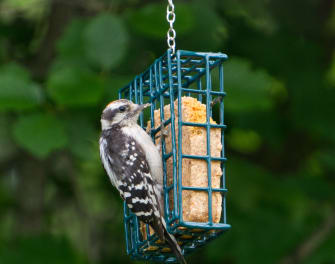The word “suet” refers to a hard type of white fat that’s found near the kidneys of cattle and, to some degree, sheep. People sometimes use suet in cooking (particularly in England) and in soap and candle making. This substance is also used to form nuts, seeds, and other bits of food into a solid cake form—and that’s what people refer to when discussing suet cakes for wild birds.

Birds can metabolize animal fat and use it for energy—meaning, energy for immediate use and the type they’ll store for future needs. The second type can be especially valuable as birds are preparing for or living through the winter season with suet cakes providing them with high levels of nutrition. Suet also helps birds in springtime when they’re busy building nests, but food sources aren’t plentiful.
Suet bird food attracts numerous types of birds, particularly woodpecker species. Other bird species that enjoy suet cakes include chickadees, crows, goldfinches, jays, nuthatches, robins, sparrows, starlings, warblers, and wrens.
When choosing suet products, it’s important to consider the suet itself, as well as the feeder you’ll use to provide the food to wild birds on your property. If you have questions about purchasing wild bird supplies, stop by Decker’s Nursery; contact us online; or call (631) 261-1148.
Quick History of Bird Feeding
In Walden, Henry David Thoreau’s classic book from 1854, he shares how he enjoys providing corn to birds and watching blue jays and black-capped chickadees feed outside his cabin. By 1898, people already recognized the value of using suet to attract birds with a teacher at Smith College, Florence Merriam Bailey, teaching her students about this practice and noting how it attracted such a wonderful diversity of wild birds.
So, if you appreciate birdlife and want to help keep them nourished, it makes sense to explore the magic of bird suet and seed.
Ingredients in Suet Cakes for Birds
Suet serves as the ingredient that binds bird feed together, and what that feed is can vary by brand and product. For example, the suet may hold nuts, seeds, oats, corn, wheat, peppers and more together. So, if you want to attract a particular species of bird to your yard, you’ll want to choose suet products that contain the food that this bird species enjoys.
High quality suet fat is melted down with impurities skimmed off. This allows manufacturers of premium quality bird feed to use pure suet to form nourishing cakes for the wild birds that contain these ingredients.
Sourcing and melting your own suet is a messy, time-consuming process, which is why we carry ready to use and easy to store products for your use.
Bird Suet Options
When using a low to mid-level quality of suet cakes for birds, you typically wouldn’t use it in warmer weather because the fat could melt. If you want to use this type of bird food throughout the year, you can use cakes that include no-melt suet. Another benefit of no-melt products: you can buy in bulk and use the food as needed.
As another option, you can select high quality no-melt suet dough as well as the right blend of nutritional food that’s designed to be included in a suet cake. For example, you could choose this suet blend that includes nature’s best all in one. It includes sunflower meats, raw peanuts, pecans, berry and insect Suet Kibbles™, currants, cranberries, and apple slices. Described as the “ultimate trail mix for your wild birds,” you can combine this with your suet dough and put it out in your bird feeders to attract bluebirds, cardinals, robins, warblers, woodpeckers, and more.
Important Ingredient: Patience
When you first put out suet bird food, wild birds may not instantly flock to the feeder—even when they’re clearly in need of nourishment. Why? Although some bird species have a wonderful sense of smell that attracts them to the food they require, most don’t. Most birds use their vision to spot new sources of food, which can involve flying around a certain area until they spy something interesting.
So, when you provide suet cakes for birds, give them a chance to locate this new source. (Once they recognize that nourishment is available in your yard, they’ll return.) Wild birds eat only a small amount at a time in frequent intervals. This means they’ll likely swoop down for a snack and then come back later for more. Plus, they instinctively know to look out for predators that might harm them, so they’re in regular motion in a state of alert as they look for food.
Suet Cake Bird Feeders
Bird feeders come in multiple varieties of styles and structures, each designed to contain certain types of food for your flying friends. Besides choosing the right brand and quality of suet food, you’ll want to have the optimal feeder for suet, a feeder created to house the cake’s typical size. This mesh bird feeder, for example, is ideal for suet. That’s just one option, so we encourage you to browse our website or stop by to find the right ones for your needs, including our green solutions.
Hang your bird feeder in a protected spot that’s about a foot away from a tree or shrub and at least a yard away from any windows or other glass—making sure it’s a good spot for indoor bird watching. If so, give this location a try. If needed, adjust the spot to one that works better for the birds and you.
Visit Decker’s Nursery
We care about our feathered friends and the bird lovers who feed them. That’s why we offer quality brands at competitive prices—so you can confidently feed wild birds with the right products.
If you have questions about the best suet cakes for wild birds you want to attract, stop by our retail garden center and one of our experts will gladly discuss what’s optimal for you. Or you can contact us online or call (631) 261-1148.
